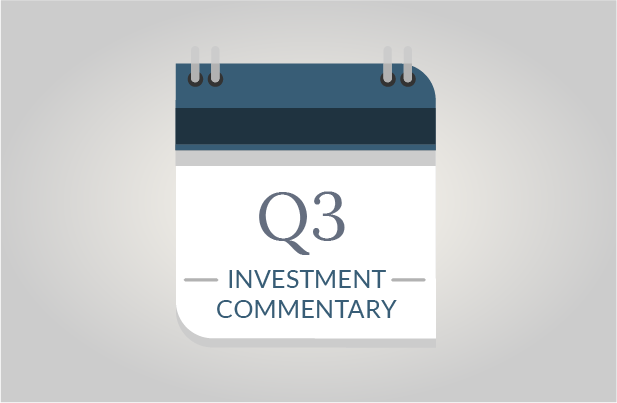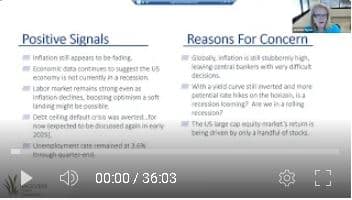- The investment markets stumbled during the third quarter due to several negative events.
- Fortunately, the U.S. economy remains strong.
- A government shutdown was averted, but not resolved.
Pullback in the Markets
A number of factors had a negative impact on the markets during the third quarter. Historically, September has been a challenging month for stocks, and fundamental events this year directly contributed to recent market declines. These namely include a near government shutdown, Fitch downgrading the U.S. credit rating in early August, and the Fed’s comments that higher rates could persist during its mid-September meeting.
While investment returns lost ground in recent months, it is important to note that year-to-date returns remain positive with stocks leading the way. Such gains help to retain investment recovery after a difficult year in 2022. Furthermore, many economic considerations remain encouraging, giving opportunity for resumed market gains.
A summary of key investment market returns as of September 30, 2023 is as follows:
Bloomberg U.S. Aggregate (U.S. bonds) -1.21%
S&P 500 Index (large U.S. stocks) 13.07%
Russell 2000 (small U.S. stocks) 2.54%
MSCI All Country World Index ex-US 5.34%
(International Stocks)
Continued Economic Strength
While the markets retrenched in the third quarter, the most recent economic reports indicate that the economy has remained resilient. This is a positive consideration relevant to future returns.
U.S. GDP growth is the primary measure of economic growth. The most recent figures for the second quarter reported a 2.1% annualized growth rate in the economy. This confirms that we did not enter a recession through the second quarter. More recent data in the third quarter includes strong employment figures with accelerated hiring in September. There was also an uptick in August’s consumer spending. These suggest continued economic growth.
Risks are always present such as rising oil prices and the resumption of student loan payments. However, it’s encouraging that we’ve maintained a solid economic footing in the face of protracted economic concerns.
Ongoing Government Shutdown Concerns
A current widely discussed U.S. topic is the potential for a U.S. government shutdown. Fortunately, Congress reached a short-term agreement to avoid a September 30th shutdown. However, a long-term resolution is required by November 17th. The ousting of Kevin McCarthy as Speaker of the House adds another layer of uncertainty. The House now needs a new leader, and someone who can achieve the necessary votes by the November 17th deadline.
Government shutdowns can have a material impact on the economy and people’s livelihoods. However, they’re not necessarily a doomsday event for the investment markets. Looking historically, the U.S. government has shut down 21 times since 1976 for varying timeframes of up to just over a month in duration. While there were instances of market declines during shutdown periods, that occurred less than 50% of the time. Furthermore, the severity of the declines was fairly modest, ranging from drops of less than 1% to under 5%. Hence, the risks of a further market decline during a potential government shutdown exist, but a decline is not a foregone conclusion.
U.S. Credit Downgrade
Looking earlier in the third quarter, the most notable impact to market performance was Fitch (a credit rating agency) downgrading the U.S. credit rating on August 1st. The downgrade was attributed to increasing U.S government disfunctions and risk factors.
Stocks and bonds experienced an immediate and material setback when the downgrade was announced. It triggered a spike in interest rates due to potentially higher U.S. investment risk. Higher interest rates negatively impact investment returns of both stocks and bonds for a variety of reasons. Higher rates also push mortgage rates higher, which are now over 7% and at the highest levels in over a decade.
U.S. credit downgrades have been extremely rare with only two instances in our nation’s history despite a long list of challenging periods. We resumed the highest credit rating after the first downgrade in 2011, and there’s certainly reason to believe that we can do so again. In the meantime, the risk of a government shutdown and a first fallen Speaker of the House don’t help immediate credit considerations.
On a more positive note, the U.S. dollar has remained strong and has continued to rise since the credit downgrade.
Recent Fed Comments
Statements by the Federal Reserve also impacted the markets in September. Fortunately, the Fed kept rates unchanged at the September meeting, but they alluded to another rate increase on the horizon. They also stated that relatively high rates could be maintained for the foreseeable future. As previously noted, high interest rates are unfavorable for investments and mortgage rates as they increase borrowing costs for consumers and businesses.
Thankfully, inflation rates have fallen quite a bit since last year, down from 9% into the 3% range. However, the annual inflation rate did tick up a bit, to 3.7% in August. September’s increase in oil prices could put upward pressure on upcoming inflation readings.
While the Fed’s most recent comments suggested that elevated rates could persist, future economic figures and events can easily change. This means that the future of Fed rates is always unknown. If the economy remains strong, rates could sustain. However, if inflation and/or economic growth decline, the Fed could easily lower rates. Predictions should always be taken with a grain of salt.
Israel Hamas War
Just after the quarter’s end, Hamas attacked Israel, initiating a full-blown war. Details, such as Iran’s backing, are still being investigated. While it is too early to know what the global impacts may be, investors are remaining calm. Oil prices rose on the first trading day after the war began but stabilized on the second day. Furthermore, the U.S. and international stock markets have posted positive returns. While the humanitarian crisis is disturbing, the markets have taken a wait-and-see approach as they have become accustomed to international conflict.
Looking Ahead
Market downturns, such as the downturn during the second quarter, are never pleasant and can cause investor anxiety. However, we remind investors that the markets have always recovered in the past. Furthermore, buying during market dips has historically proven to be profitable over the long run. SageVest made small purchases into stocks, where appropriate for specific clients, during this recent downturn. We also note that the fourth quarter is frequently a strong period for investments. We certainly hope that common occurrence will happen again this year.
As always, we continue to monitor and evaluate the economy and investment markets on your behalf, implementing changes relevant to your financial goals. Please contact us with any questions.
SageVest Wealth Management




